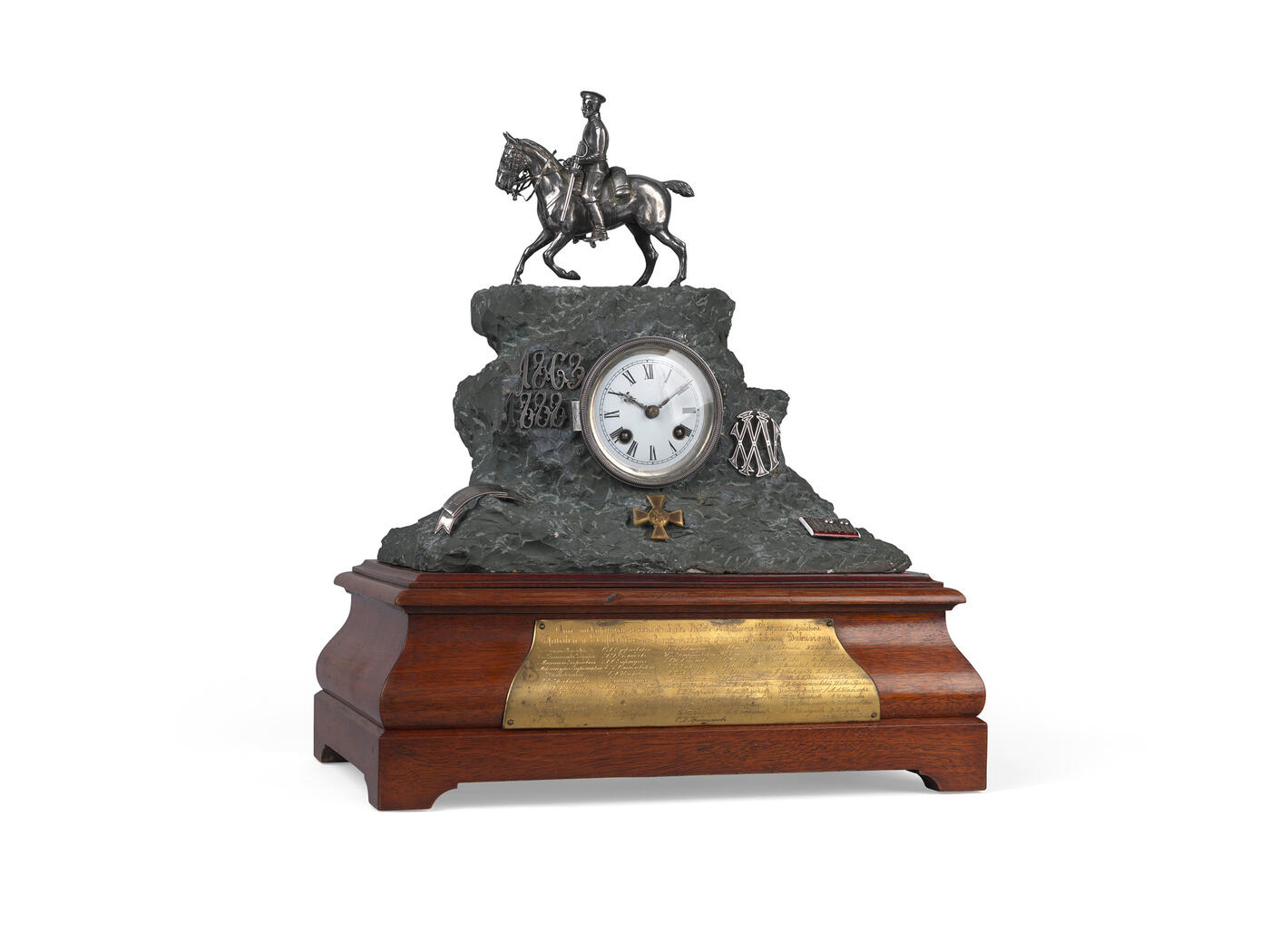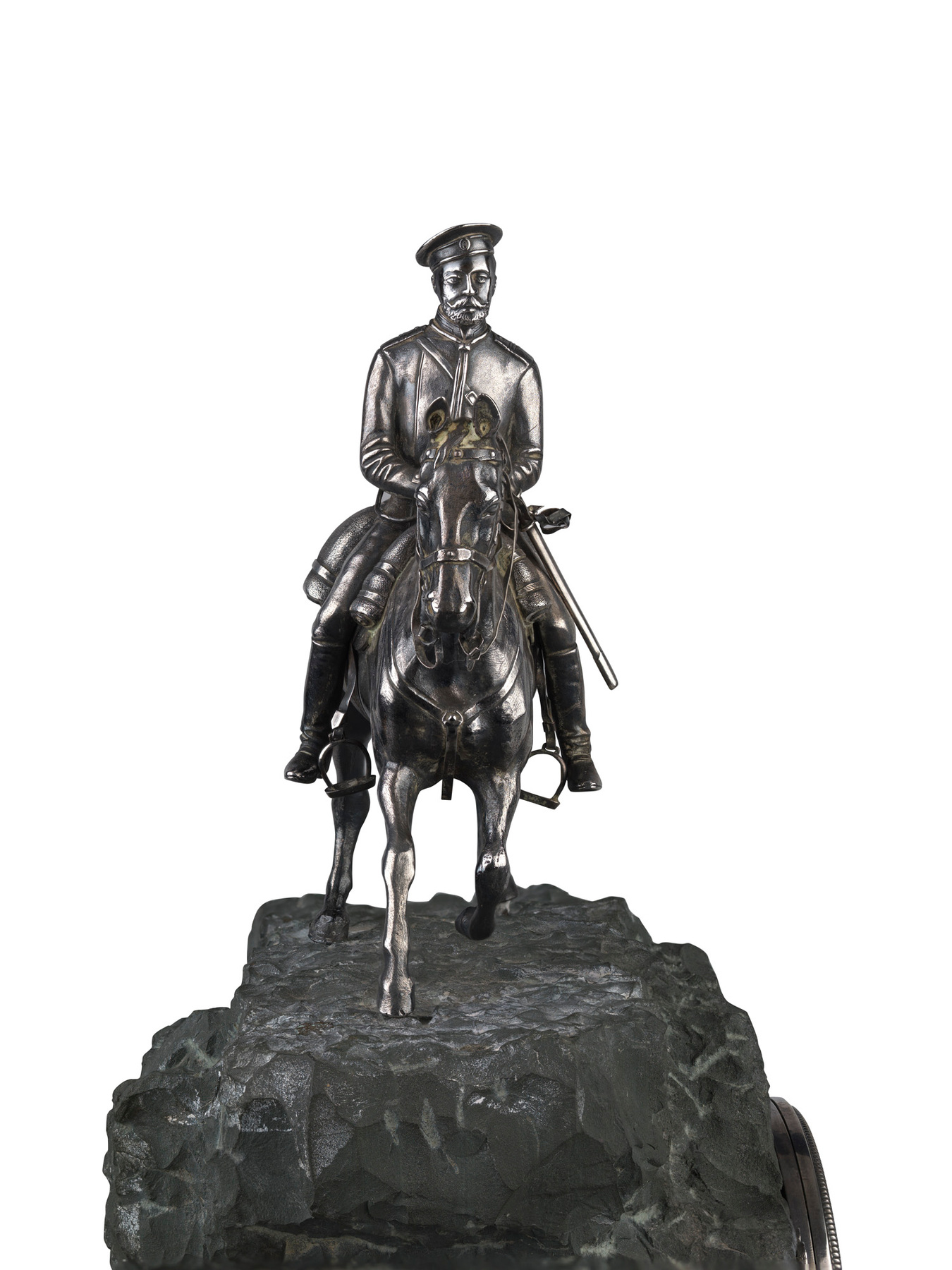4 June 2014 Russian Art Auctions
4 June 2014

525. A PRESENTATION EQUESTRIAN MANTEL CLOCK WITH MUSICAL CHIME
LYUBAVIN, ST. PETERSBURG,1904, 84 STANDARD
Height 45 cm, base 40.5 by 25 cm.
70,000–90,000 GBP
The green-grey hardstone chiselled to imitate a rocky outcrop, centred with a circular white dial with black Roman numerals within plain silver bezel and applied with dedication plaque “For distinguished conduct in Russo-Turkish war of 1877–1878”, Roman and Arabic numerals “XXV” and “1863.1888» and the badge of the Order of St. George and enamelled epaulettes, mounted with a silver cast and finely chased figure of a horse with mounted artilleryman; the wooden base containing musical movement with a commemorative plaque engraved in Cyrillic “From colleagues and comrades-in-arms of the Life-Guards of the 1st Artillery Squadron and Field Artillery Battalion” and a list of sixty officers.
This fine clock with an equestrian figure was presented to an unnamed distinguished officer who served in the Life-Guards of the 1st Artillery Squadron and Field Artillery Batallion. The red and white colours of the enamel epaulettes on the clock correspond to the colours of the wrist-cuffs and welts of the uniform of this military unit. The clues to the identity of the officer can be found in the names of his colleagues listed on the plaque. Among them: General-Major M. Meklenburg-Strelitskii (Commander of the Squadron 1903–1908), Colonels V. Lekhovich, N. Demidov, E.Smyslovskii and N. Il’kevich, Captain G.Veshnyakov and Staff-Commander N. Belyaev. The military register proves that these officers at some point in their military career all served in the Life-Guards of the 1st Artillery Squadron. The majority of them were still serving in that Squadron in 1904 when the clock was presented.
The Life-Guards unit of the 1st Artillery Squadron was founded in 1796 and participated in the Russo-Turkish war (1877–1878) and World War I; the Field Artillery Battalion was founded in 1898 and disbanded in 1918. Both units were based in St. Petersburg.
The dedication plaque “For distinguished conduct in Russo-Turkish war of 1877–1878” indicates that the officer to whom the clock was presented, also participated in that war and was awarded the Order of St. George. Research into the Order’s knights who would match these criteria has produced only one name – that of Colonel Alexander Onoprienko.
Alexander Onoprienko (1827 – after 1917) was awarded the 4th Class Order of St. George in 1878. By 1904, he was the Commander of the Life-Guards 1st Artillery Squadron for 25 years (from 1879), and in 1888 he also took command of the 2nd Artillery Squadron. He participated in the suppression of the Polish rebellion in 1863 and was in charge of the St. Petersburg military district from 1895. Onoprienko resigned from this post on the 12th August 1904. Therefore, it is reasonable to assume that the present lot was a leaving present from his colleagues.
The history of the Russian army and the dramatic events of the first quarter of the 20th century are all reflected in this clock, which makes it not only a remarkable timepiece and work of art, but above all a historical artifact of particular importance to collectors.

Notes on symbols:
* Indicates 5% Import Duty Charge applies.
Ω Indicates 20% Import Duty Charge applies.
§ Indicates Artist's Resale Right applies.
† Indicates Standard VAT scheme applies, and the rate of 20% VAT will be charged on both hammer price and premium.